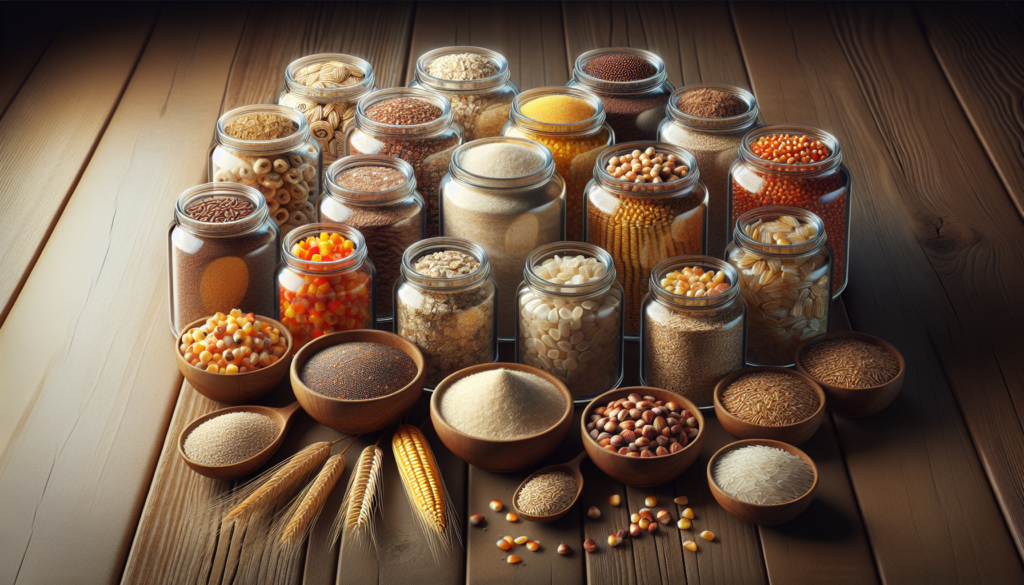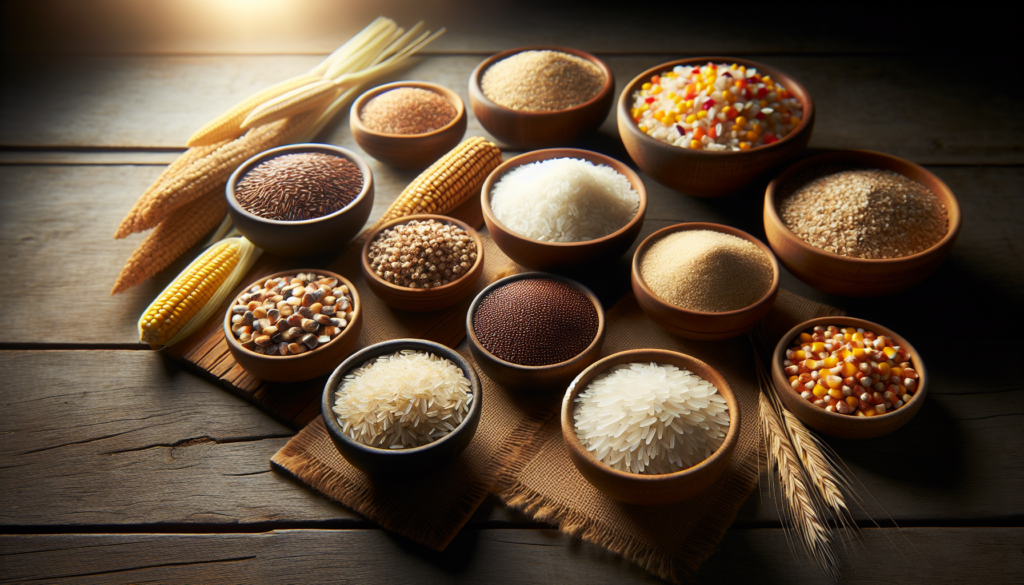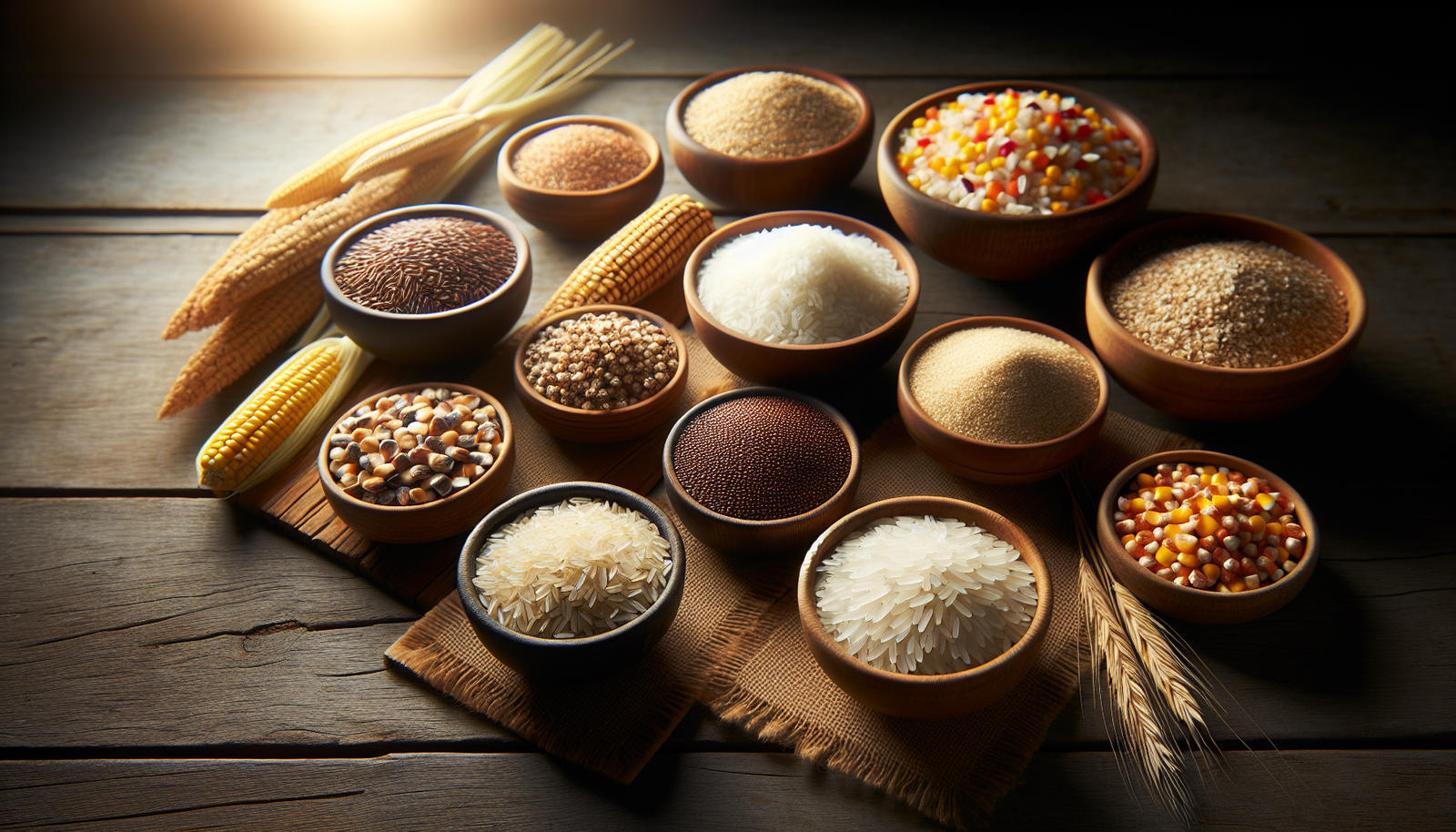Are you one of the many people who are sensitive to gluten? If so, you may have been struggling to find suitable alternatives to wheat in your diet. Don’t worry, we’ve got you covered! In this article, we will explore a variety of wheat alternatives that are perfect for those who are gluten-sensitive. From nutritious grains to creative substitutes, we will provide you with all the information you need to make delicious, gluten-free meals that will satisfy your cravings. So, let’s dive in and discover the wonderful world of wheat alternatives for the gluten-sensitive!
Grains
Quinoa
Quinoa is a versatile grain that has gained popularity in recent years, especially among those with gluten sensitivities. This grain is actually a seed, but it is often referred to as a grain due to its grain-like appearance and texture. Quinoa is packed with nutrients and is a complete protein, meaning it contains all nine essential amino acids. It is also a great source of fiber and minerals such as magnesium and iron.
Amaranth
Amaranth is a nutritious and gluten-free grain that has been cultivated for thousands of years. Like quinoa, amaranth is technically a seed, but it is commonly consumed as a grain. It is rich in protein, fiber, and essential minerals like calcium and magnesium. Amaranth has a slightly nutty flavor and a delicate texture, which makes it a great addition to both sweet and savory dishes.
Millet
Millet is a small, round grain that is often overlooked but deserves more attention. It is naturally gluten-free and provides a good source of nutrients, including B vitamins, iron, and antioxidants. Millet has a mild flavor and a light, fluffy texture, making it a great substitute for couscous or rice. It can be used in a variety of dishes, such as salads, pilafs, and even porridge.
Rice
Rice is a staple grain in many cuisines around the world, and luckily, it is naturally gluten-free. There are numerous varieties of rice available, including brown, white, basmati, and jasmine rice. Each type has its own unique flavor and texture, making it suitable for a wide range of dishes. Rice is also a good source of energy and provides essential nutrients like carbohydrates and B vitamins.
Oats
Oats are a popular breakfast option and a great alternative to wheat-based cereals. While oats themselves are naturally gluten-free, they are often processed in facilities that also handle gluten-containing grains, leading to possible cross-contamination. Therefore, it is important to choose certified gluten-free oats if you have a gluten sensitivity. Oats are not only nutritious but also versatile. They can be enjoyed as oatmeal, used in baking, or added to smoothies for an extra boost of fiber.
Seeds
Chia seeds
Chia seeds have gained popularity in recent years due to their numerous health benefits. These tiny seeds are packed with fiber, protein, and omega-3 fatty acids. They also have a unique ability to absorb liquid, forming a gel-like consistency. This makes them a fantastic addition to puddings, smoothies, and baked goods. Chia seeds are naturally gluten-free and can be enjoyed by individuals with gluten sensitivities.
Flaxseeds
Flaxseeds are another healthy seed option for those who need to avoid gluten. They are an excellent source of omega-3 fatty acids, fiber, and antioxidants. Flaxseeds have a slightly nutty flavor and can be ground into a meal or used as whole seeds. They can be added to smoothies, sprinkled on top of yogurt, or used as an egg substitute in baking. Flaxseeds are a versatile and nutritious addition to a gluten-free diet.
Hemp seeds
Hemp seeds are a fantastic source of plant-based protein and healthy fats. They are rich in omega-3 and omega-6 fatty acids, making them beneficial for heart health. Hemp seeds have a mild, nutty flavor and can be easily incorporated into a variety of dishes. They can be sprinkled on salads, added to smoothies, or used as a topping for yogurt. Hemp seeds are naturally gluten-free and provide a great alternative source of nutrients for those with gluten sensitivities.
Sunflower seeds
Sunflower seeds are not only a tasty snack but also a nutritious addition to a gluten-free diet. They are a great source of healthy fats, protein, and essential minerals like magnesium and selenium. Sunflower seeds have a mild, nutty flavor and can be enjoyed on their own, added to trail mixes, or used as a topping for salads and cereals. They are a budget-friendly option for individuals looking to incorporate more gluten-free seeds into their diet.

Legumes
Lentils
Lentils are a type of legume that are high in protein, fiber, and essential vitamins and minerals. They come in various colors, including red, green, and black. Lentils have a mild, earthy flavor and can be cooked in a variety of ways. They can be used to make soups, stews, curries, or even veggie burgers. Lentils are naturally gluten-free and provide a great source of nutrients for those on a gluten-free diet.
Chickpeas
Chickpeas, also known as garbanzo beans, are a versatile legume that can be enjoyed in many different forms. They are rich in protein, fiber, and complex carbohydrates. Chickpeas can be used to make hummus, roasted as a crunchy snack, or added to salads and soups. They are a staple ingredient in many gluten-free dishes and provide a good source of plant-based nutrients.
Soybeans
Soybeans are a popular legume that is often processed into various forms such as tofu, tempeh, and soy milk. They are a complete source of protein and provide essential amino acids. Soybeans are also rich in fiber and contain beneficial compounds called phytoestrogens. While some individuals may have soy allergies or sensitivities, for those who can tolerate it, soybeans can be a valuable addition to a gluten-free diet.
Nut Flours
Almond flour
Almond flour is made from finely ground almonds and is a popular gluten-free alternative to traditional wheat flour. It is naturally grain-free and provides a good source of healthy fats, protein, and fiber. Almond flour has a light, slightly sweet flavor and works well in both sweet and savory recipes. It can be used in baking, as a coating for meats, or as a thickener for sauces and soups. Almond flour is a nutritious and delicious option for those on a gluten-free diet.
Coconut flour
Coconut flour is made from dried coconut meat and is an excellent gluten-free alternative to traditional flours. It is low in carbohydrates, high in fiber, and rich in healthy fats. Coconut flour has a mild, coconut flavor and a unique ability to absorb liquid. This makes it a great option for baking moist and flavorful cakes, muffins, and bread. Coconut flour is not only gluten-free but also adds a tropical twist to your gluten-free recipes.
Hazelnut flour
Hazelnut flour is made from finely ground hazelnuts and is a flavorful option for those on a gluten-free diet. It is high in healthy fats, protein, and fiber. Hazelnut flour has a rich, nutty flavor and works well in both sweet and savory dishes. It can be used in baking, as a coating for meats, or added to homemade granola and energy bars. Hazelnut flour adds a delightful taste and texture to gluten-free recipes.

Potato Starch
Benefits of potato starch
Potato starch is a gluten-free alternative to traditional wheat flour and can provide numerous benefits in the kitchen. It is a fine white powder made from the starch of potatoes, and it has a neutral flavor. One of the main benefits of potato starch is its ability to thicken sauces, gravies, and soups without adding a strong taste. It also helps create a smooth texture in baked goods and can contribute to a lighter and fluffier finished product.
Cooking with potato starch
Potato starch can be used as a versatile ingredient in various cooking and baking applications. It is an excellent thickening agent and can be added to soups, stews, and sauces to achieve the desired consistency. When using potato starch in baking, it is important to remember that it absorbs moisture differently than wheat flour. It is best to use specific gluten-free recipes that have been developed with potato starch or other gluten-free flours in mind.
Gluten-free recipes using potato starch
There are endless possibilities when it comes to gluten-free recipes using potato starch. It can be used to make gluten-free bread, cookies, cakes, and even pasta. Potato starch can be combined with other gluten-free flours like rice flour or tapioca starch to achieve the desired texture and taste. Some popular gluten-free recipes using potato starch include fluffy pancakes, crispy fried chicken, and creamy sauces. The key to successful gluten-free cooking with potato starch is experimenting with recipes and adjusting the ratios to suit your preferences.
Tapioca Starch
Uses of tapioca starch
Tapioca starch, also known as tapioca flour, is a common ingredient in gluten-free baking and cooking. It is derived from the starchy root of the cassava plant and has a smooth, powdery texture. Tapioca starch is a versatile ingredient and can be used as a thickener, binder, or texture enhancer in a wide range of recipes. It is commonly used in gluten-free bread, cookies, and cakes to improve their texture and moisture retention.
Tapioca starch vs wheat flour
One of the main advantages of tapioca starch compared to wheat flour is its gluten-free nature. Tapioca starch contains no gluten, making it an excellent option for those with gluten sensitivities or celiac disease. Additionally, tapioca starch has a neutral flavor and a light texture, which allows it to blend well with other gluten-free flours. It can contribute to a more elastic and tender crumb in baked goods without adding a strong taste.
Tapioca starch-based recipes
Tapioca starch can be used to create a variety of gluten-free recipes. It can be combined with other gluten-free flours like rice flour or almond flour to make delicious bread, muffins, and cookies. Tapioca starch-based recipes often have a chewy and springy texture, similar to traditional wheat-based baked goods. Some popular recipes include Brazilian cheese bread, tapioca pudding, and crispy onion rings. Tapioca starch adds versatility and texture to gluten-free cooking and baking.
Buckwheat
Health benefits of buckwheat
Buckwheat is an ancient grain that is naturally gluten-free and provides numerous health benefits. It is a good source of fiber, protein, and essential minerals like magnesium and manganese. Buckwheat is also rich in antioxidants, which can help reduce inflammation and support heart health. This versatile grain can be used in a variety of dishes, from pancakes and noodles to salads and pilafs. Its nutty flavor and unique texture make it a popular choice for those on a gluten-free diet.
Buckwheat recipes
There are countless delicious recipes that incorporate buckwheat as a gluten-free alternative. Buckwheat can be ground into flour and used to make fluffy pancakes, tender crepes, or hearty bread. It can also be used to make soba noodles, which are a staple in Japanese cuisine. Buckwheat is often used as a base for salads, providing a satisfying crunch and a nutty taste. Some popular buckwheat recipes include buckwheat porridge, buckwheat salad, and buckwheat muffins.
Buckwheat vs wheat
Buckwheat is often hailed as a healthy substitute for wheat due to its gluten-free nature and unique nutritional profile. Unlike wheat, buckwheat does not contain gluten, making it a safe option for those with gluten sensitivities or celiac disease. Additionally, buckwheat is higher in fiber and certain nutrients compared to wheat. It has a lower glycemic index, which means it can help regulate blood sugar levels. Buckwheat also offers a distinctive flavor and texture that sets it apart from wheat-based products.
Sorghum
Why sorghum is gluten-free
Sorghum is a gluten-free grain that has been consumed for centuries in many parts of the world. It is a versatile grain that can be used in various forms, including whole grain, flour, and syrup. Sorghum is naturally gluten-free because it does not contain the proteins that are responsible for gluten formation. This makes it a suitable alternative for individuals with gluten sensitivities or celiac disease. Sorghum is also a good source of fiber, protein, and essential minerals like iron and phosphorus.
Sorghum-based products
Sorghum can be processed into various gluten-free products that cater to different dietary needs. Sorghum flour, for example, can be used as a substitute for wheat flour in baked goods. It has a slightly sweet and nutty flavor, which can add depth to gluten-free bread, cookies, and muffins. Sorghum syrup is another popular product made from the juice extracted from the sorghum plant. It is commonly used as a natural sweetener in baking and cooking.
Sorghum flour recipes
Sorghum flour can be used to create delicious and gluten-free recipes. It can be blended with other gluten-free flours like rice flour or tapioca starch to make bread, pizza dough, or pie crusts. Sorghum flour-based recipes often have a slightly denser texture compared to traditional wheat-based recipes. Some popular gluten-free recipes using sorghum flour include banana bread, chocolate chip cookies, and apple crumb cake. Sorghum flour adds a unique flavor and nutritious element to gluten-free baking.
Corn
Corn as a gluten-free option
Corn is a naturally gluten-free grain that has been a staple in many cultures for centuries. It is a versatile ingredient that can be used in various forms, from whole corn kernels to cornmeal and corn flour. Corn is a good source of carbohydrates, fiber, and certain vitamins and minerals. It can provide energy and nutrients for individuals on a gluten-free diet while adding a sweet and satisfying taste to meals.
Types of corn products
Corn comes in a variety of forms, each with its own unique culinary uses. Whole corn kernels can be boiled, grilled, or roasted as a side dish or added to soups, salads, and salsas. Cornmeal, made by grinding dried corn, is commonly used to make bread, tortillas, and cornbread. Corn flour, which is finer than cornmeal, can be used as a coating for fried foods or as a thickening agent in soups and sauces. Cornstarch, a type of corn flour, is often used to thicken gravies and puddings.
Incorporating corn into your diet
Incorporating corn into a gluten-free diet can be both delicious and nutritious. Corn can be enjoyed in various ways, including as a side dish, in salads, or as part of main courses. Grilled corn on the cob with a sprinkle of salt and butter is a classic summer treat. Corn tortillas can be used to make tacos, enchiladas, or quesadillas. Fresh corn kernels can be added to salads, soups, or stir-fries for a burst of flavor and texture. The possibilities with corn are endless, and it can be a delightful addition to a gluten-free menu.
Teff
Introduction to Teff
Teff is a gluten-free grain that has been cultivated in Ethiopia for thousands of years. It is often used to make injera, a traditional Ethiopian flatbread. Teff is rich in essential nutrients such as iron, calcium, and fiber. It has a mild, nutty flavor and a slightly gritty texture. Teff is available in different colors, including white, brown, and red. It can be cooked as a whole grain or ground into flour for baking and cooking purposes.
Teff-based dishes
Teff can be used to create a variety of tasty and gluten-free dishes. Injera, the Ethiopian sourdough flatbread, is one of the most well-known teff-based dishes. It is used as a staple in Ethiopian cuisine and is often served with stews and curries. Teff flour can also be used to make pancakes, muffins, and cookies. It adds a unique flavor and texture to gluten-free baking and provides a nutritious alternative to traditional wheat-based recipes.
Teff flour in baking
Teff flour is a fantastic gluten-free alternative that can be used in a wide range of baking recipes. It has a slightly sweet and nutty flavor, which adds depth to bread, cakes, muffins, and cookies. Teff flour can be used on its own or combined with other gluten-free flours like rice flour or sorghum flour. It is important to note that teff flour has a high fiber content, which can affect the texture and moisture of the final baked goods. Experimentation and adjustments may be needed to achieve the desired results in gluten-free baking with teff flour.
In conclusion, there are many wheat alternatives available for individuals with gluten sensitivities. From grains like quinoa and amaranth to seeds like chia and flaxseeds, there is a wide variety of options to choose from. Legumes like lentils and chickpeas provide a good source of protein, while nut flours like almond and coconut flour add flavor and texture to gluten-free recipes. Potato starch and tapioca starch can be used as versatile ingredients in cooking and baking, while grains like buckwheat and teff offer unique taste and nutritional profiles. By incorporating these wheat alternatives into your diet, you can enjoy a delicious and gluten-free eating experience.

